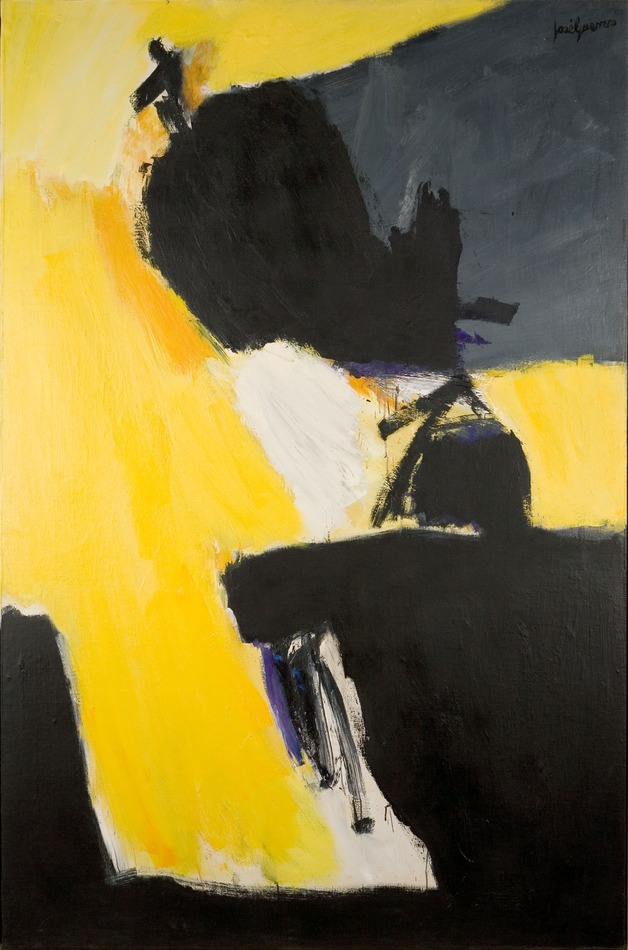Antojos Negros con Amarillos (Black Whims with Yellow)
signed upper right: José Guerrero
titled, signed and dated “1966” on verso
Provenance:
Galeria Juana Mordó, Madrid
Exhibited:
Nüremberg, Nüremberg Kunsthalle, “Spanische Kunst der Gegenwart,” 4 Nov 1967 – 7 Jan 1968, no. 35 (as Launisch weiß und Schwarz).
Rotterdam, Museum Boymans-Van Beuningen, “Hedendaagse Spaanse Kunst: van Picasso tot Genovés,” 5 Jul – 25 Aug 1968, no. 46 (as Geel).
New York, The Instituto Cervantes and El Museo del Barrio, “The Spanish Nexus: Spanish Artists in New York 1930-1960,” 11 Nov 2009 – 10 Jan 2010.
Literature:
Ashton, Dore, Juan Manuel Bonet, Carmen Caffarel, Elvis Fuentes, et. al. El Nexo Espagñol, Instituto Cervantes, New York, 2009, p. 49 (illustrated).
Bozal, V., Summa Artis Vol. XXXVII: Pintura y escultura españolas del siglo XX (1939-1990). Espasa Calpe, Madrid, 1992, rep. Color, p. 428 (as Capricho negro y amarillo and with incorrect date of 1967)
Moreno Galván, J. M., Pinutra española. La última vanguardia. Magius, Madrid, 1969, com. p. 190, rep. color, s. p.
Romero, Yolanda & Ines Vallejo. Jose Guerrero: Catalogo razonado. vol. 1 (1960 – 1969) Granada: Centro Jose Guerrero Telefonica, 2007, p. 566, no. 462.
*Ines Vallejo notes that the painting is listed with incorrect dimensions of 146 x 114 cm. and incorrect date of 1967 in the catalogue raisonné. The information will be corrected in the forthcoming CD version of the catalogue raisonné.
Guerrero moved to NY in 1950 and showed his work alongside Pollock, Still, Newman, Rothko, and Reinhardt at Betty Parsons Gallery through the decade of the 1950s. Through the latter half of the 1950s, Guerrero's work became more confident, expressive and about the pleasure of painting. After the beginning of the 60s, a shift in taste caused a change in the Abstract Expressionist movement. Many of the Abstract Expressionist painters turned to formal concerns and Pop Art replaced Abstract Expressionism at galleries such as Betty Parsons. It was the necessity of change, caused by this shift in the art world that lead to Guerrero's return to Spain in 1962 and the development of his mature phase during the 1960s.
Guerrero had always been a colorist, from the beginning of his career in the 1940s through to his work from the 70s. His work was essentially expressionist in nature, and while he worked in modes that were both constructive and deconstructive, analytical and expressive, his essential underlying concern was with color. This fundamental concern with brilliance and luminosity prevented his work from becoming formalist in nature, and as the American art world changed, Guerrero became only more clear about how he wanted to paint. Given that his work possessed a lyricism that brought him closer to Motherwell and Klein and the Parisian approach to abstraction, combined with the fact that Pop Art could not take root in Spain, Guerrero returned to his homeland, not as an act of resignation or as a defeated creator, but in order to maintain the vitality of his work. It is in this context, with the ability to renew his Spanish roots, that Guerrero was able to develop a new manner and a more personal, mature style. His color became more clean, and his work obtained a depth and sense of contained passion that is essentially Spanish.
Request more information
News on the artist
-
So many great works, I'll need a whole day to take them in! #Picasso 's Drawings, 1890–1921 @frickcollection http://t.co/lDltKipc #ModernismOctober 5, 2011 @ 5:29 PM UTC
-
What a tragedy! Paris art theft suspect threw paintings in garbage http://t.co/uT7aJKID #Modernism #Fauve #Matisse #Leger #Braque #PicassoOctober 10, 2011 @ 4:56 PM UTC
-
October 24, 2011 @ 3:45 PM UTC
-
Upcoming Gagosian #Picasso #exhibition to focus on his years with the still-beautiful Francoise Gilot - http://t.co/6SI61DIM #ModernismOctober 25, 2011 @ 8:47 PM UTC
-
Balkans targeted in hunt for stolen art - The Art Newspaper http://t.co/50TKhA71 #Modernism #PicassoJanuary 20, 2012 @ 4:20 PM UTC
-
"Georges #Rouault Circus of the Shooting Star" at the Utah Museum of Fine Arts: http://t.co/GOPo4LfT via @AddThis #exhibitions #ModernismFebruary 6, 2012 @ 10:40 PM UTC
-
Munch's 'The Scream' Lands Record Price for Art http://t.co/TMt2e9uX via @sharethis #Modernism #AuctionrecordsMay 3, 2012 @ 3:07 PM UTC
-
Esteban #Vicente 's "Silent" was featured in New Trads at the Armory Art and Antique Show http://t.co/AkaBFBKs @quintessenceblg #ModernismMay 21, 2012 @ 4:24 PM UTC
-
#Matisse ‘The Dance’ and the missing molding | Tyler Green: Modern Art Notes | http://t.co/VTlpmxWo via @artinfodotcom #ModernismMay 30, 2012 @ 5:26 PM UTC
-
#Matisse stolen in 2002 Recovered by FBI in Miami http://t.co/wIQEwxES via @sharethis #Modernism #museumsJuly 23, 2012 @ 2:25 PM UTC
-
July 31, 2012 @ 6:53 PM UTC
-
September 18, 2012 @ 9:43 PM UTC
-
The Museum of Modern Art announces plans to open seven days per week beginning May 2013 http://t.co/gyeQD9z3 @MuseumModernArt #modernismSeptember 27, 2012 @ 8:47 PM UTC
-
Rethinking the Armory Show : on two forthcoming centennial exhibitions on the Exhibition http://t.co/BPZSui5g #Armoryshow #Modernism #RedonNovember 19, 2012 @ 9:40 PM UTC
-
Exhibition offers unique chance to see one of #Picasso 's masterworks in an intimate setting http://t.co/zmvPbSNP #Modernism #exhibitionsDecember 18, 2012 @ 3:24 PM UTC
-
6 Things I Learned About Painting From the Met's Blockbuster #Matisse Show | Artinfo http://t.co/Z9vDF6Nd @metmuseum #ModernismJanuary 18, 2013 @ 4:22 PM UTC
-
$1 Billion Gift of #Cubist Art Transforms Met Museum - ArtfixDaily News http://t.co/tnF78mIvdU via @ARTFIXdaily #museum #Cubism #modernismApril 11, 2013 @ 2:38 PM UTC
-
Interview That Henri Matisse Didn’t Want Published Finally Gets Released 72 Years Later | http://t.co/7AYqiB6yLh #Modernism #FauvismJuly 16, 2013 @ 3:15 PM UTC
-
MoMA's first monographic exhibition of Francis #Picabia brings together some 200 works https://t.co/jqGfakxO8O #PostImpressionism #ModernismNovember 22, 2016 @ 9:30 PM UTC
-
A belated Happy Birthday to Francis #Picabia , Jan 22, 1878! https://t.co/XLM09QnKsc #artistbirthdays #Modernism #PostImpressionismJanuary 24, 2017 @ 3:58 PM UTC



